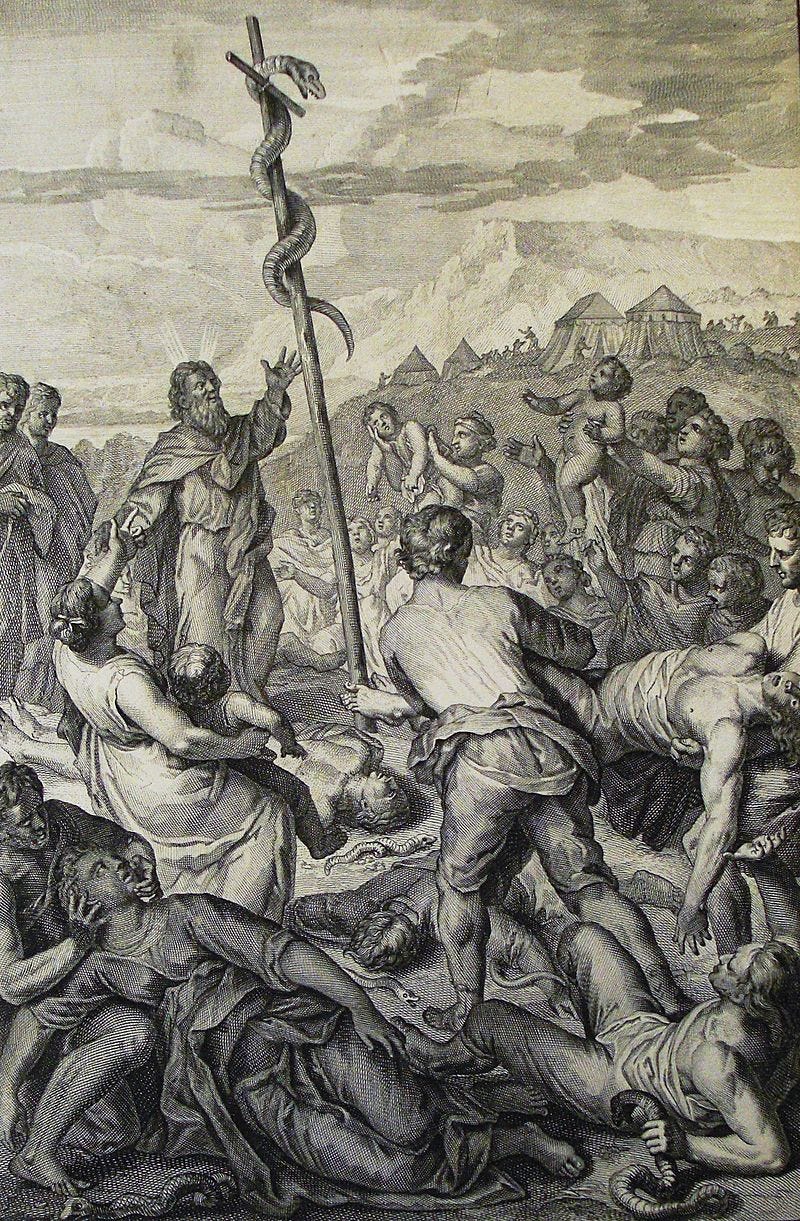Folklore Friday: Seraphim, winged serpents with venom of fire
And the time God killed his own people because they were hungry

If you read the Bible in English, you will probably only find the seraphim once by name. In Isaiah 6, the seraphim are depicted as winged serpents that fly around God’s throne. Except from the description in Isaiah, you wouldn’t notice they were serpents. They seem more like angels with hands and feet.
However, if you read the Bible in the original Hebrew, the word “seraph” (singular for the plural seraphim), pops up in a number of different texts, but is commonly translated as “serpent.”
This is one of those things where a LOT is lost in translation.
The seraphim come in a variety of different subspecies, some are more naturalistic while others are supernatural. The supernatural seraphim have wings and venom of fire. Getting bit by one sucks big time and leads to certain death.
And God won’t hesitate to use them.
Setting the Stage
In the book of Numbers, we have details on what happened after Moses led the Israelites out of Egypt and into the wilderness. God led them into Canaan to conquer and massacre the natives, but the Israelites basically back away slowly.
There is no way they can conquer these people. They are huge and well armed, and the Israelites were slaves, not warriors.
And to be fair, when God finally does lead his people in battle against the Canaanites, he loses in the valleys because the Canaanites have iron chariots and God isn’t all-powerful (Judges 1:19). Granted this was a generation later, but even then, they still weren’t in a position to fight off an entire nation.
But that’s later in the story.
So the Israelites say, “We can’t do this. We will die and our children and women will be carried off as slaves.”
God replies with, “Oh yeah? Well f*ck you. I’m going to drive you into the desert and kill you there myself. I’m going to make your children suffer in the desert until every one of you is dead.” (Numbers 14:26-35). It’s a pretty long screed.
The people who complained try to repent, and offer go to war with the Canaanites, but God says, “Well, now I’m not doing it.”
And the Israelites get slaughtered, just like they said they would.
So God leads the rest of them into the desert so he can kill them himself.
40 Years in the Desert
Over the next few chapters we get tens of thousands of people dying from hunger, thirst, plague, and the Earth opening up and swallowing people. Men, women, and children. Several times, the people gather together, grumbling that they were dying. Then more people die.
God eventually leads them from Mount Hor (located between the Edomite mountains and the Negev desert), down the trail towards the Red Sea.
And again, the people began grumbling that they didn’t have any food or water and they were dying. Which they were. God made it abundantly clear that his goal was to drive them into the desert just to kill them.
“Why, oh God,” they said. “Would you lead us out of Egypt only to kill us in the desert?”
Good question.
But now, God gets really angry. Like, annihilate them all kind of angry.
Enter, the Seraphim
God sends the seraphim to swarm the camp. He does not say, “Only bite those who spoke against me.” Nor does he say, “Kill the grumblers and those who are denied access to the Promised Land.”
He sends the seraphim in to kill indiscriminately.
And their venom is like fire.
I don’t know if the seraphim slithered in all sneaky like so no one saw it coming, or if they flew in, diving for the kill like birds from Alfred Hitchcock, but I imagine the event that followed would probably need a significant amount of trigger warnings.
The people go to Moses and say, “Sorry, we f*ucked up. We never should have complained that we were hungry and starving. Make God call off his attack!”
So Moses goes to pray. God tells him to make a bronze seraph and place it on a poll in the center of camp. Anyone who has been bitten, but looks upon the magic seraph will be healed.
And they all live happily ever after.
J/K. They were left dealing with piles of the dead, orphans and devastated families, and whatever scars and long term side effects come from being poisoned with supernatural fire venom.
Later Moses gives a speech to the Israelites encouraging them to follow the orders of God so they might live. Not to live abundantly or peacefully. “Happily ever after” isn’t the end goal of following God.
Follow God without hesitation or God will not hesitate to kill you.

If you want to know more about the seraphim, and other monsters in God’s circle, I recommend the book “God’s Monsters” by Esther Hamori.




I think it’s really interesting how the later illustration of the bronze seraph you used is so similar to the rod of Asclepius. Is there anyone theorizing a Greek influence on this occurrence of the seraph/serpent?